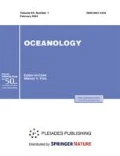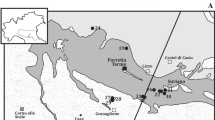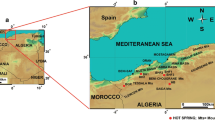Abstract
The article discusses the preliminary results of plume and bottom sediment studies of the Trollveggen hydrothermal vent field based on data from cruise 68 of the R/V Akademik Mstislav Keldysh. The hydrothermal vent field is located east of the axial zone of the slow-spreading Mohn Ridge near the Jan Mayen hotspot at a depth of about 550 m (71°18′ N, Norwegian–Greenland Basin). The hydrothermal vent field plume was characterized by a weak distribution in the water column; temperature, density, and salinity anomalies; a moderate methane concentration; and a low concentration of suspended particulate matter near the bottom. The enrichment of bottom sediments in barium, strontium, and some sulfide-forming elements (zinc, lead, copper, and molybdenum) was shown. Two mineral assemblages of hydrothermally modified bottom sediments were revealed: pyrite and barite–marcasite. The temperature of hydrothermal fluids was established by thermal and cryometric studies of gas–liquid fluid inclusions in barite (128–260°С); the FeS–ZnS equilibrium diagram of sulfide minerals was also used (130–290°С). Our data were close to direct fluid temperature measurement data [28]. We compared the hydrothermal mineralization of the Trollveggen vent field and earlier studied fields of the Mid-Atlantic Ridge located near the Azores hotspot. As a result, we confirmed the influence of ocean depth and PT conditions on the formation of hydrothermal deposits.













Similar content being viewed by others
REFERENCES
Yu. A. Bogdanov and A. M. Sagalevich, Geological Studies on Mir Submerged Apparatus (Nauchnyi Mir, Moscow, 2002) [in Russian].
Yu. A. Bogdanov, Hydrothermal Orogenesis of Rifts of the Mid-Atlantic Ridge (Nauchnyi Mir, Moscow, 1997) [in Russian].
Yu. A. Bogdanov and A. Yu. Lein, “Hydrothermal activity and its role in ocean geochemistry,” in Physical, Geological, and Biological Studies of the Oceans and Seas (Nauchnyi Mir, Moscow, 2010), pp. 350–371.
Yu. A. Bogdanov, A. Yu. Lein, and A. P. Lisitzin, Polymetallic Ores in the Rifts of Mid-Atlantic Ridge (14–40 °N): Mineralogy, Geochemistry, and Genesis (GEOS, Moscow, 2015) [in Russian].
Yu. A. Bogdanov, A. M. Sagalevich, S. V. Galkin, et al., “Geological and biological studies in the northern part of the Mohn’s Ridge (Norwegian Sea),” Oceanology (Engl. Transl.) 37, 548–555 (1997).
A. S. Borisenko, “Salt composition of gas-fluid inclusions in minerals by cryometry,” Geol. Geofiz. 8, 16–27 (1977).
Ya. V. Bychkova, I. Yu. Nikolaeva, O. S. Ermina, et al., “The details of a method for the preparation of solid geological samples for ICP-MS multielement analysis,” Moscow Univ. Geol. Bull. 73, 520–526 (2018).
L. L. Demina and S. V. Galkin, Biogeochemistry of Trace Elements in Abyssal Hydrothermal Ecosystems (GEOS, Moscow, 2013) [in Russian].
A. V. Dubinin, Geochemistry of Rare Earth Elements in the Ocean (Nauka, Moscow, 2006) [in Russian].
M. D. Kravchishina, A. N. Novigatskii, A. S. Savvichev, et al., “Studies on sedimentary systems in the Barents Sea and Norwegian–Greenland Basin during cruise 68 of the R/V Akademik Mstislav Keldysh,” Oceanology (Engl. Transl.) 59, 158–160 (2019).
A. Yu. Lein and M. V. Ivanov, Biogeochemical Cycle of Methane in the Ocean (Nauka, Moscow, 2009) [in Russian].
V. B. Naumov, O. F. Mironova, V. Yu. Prokofiev, and A. Yu. Lein, “Analysis of fluid inclusions in minerals in modern submerged hydrothermal structures,” Geokhimiya (Moscow), No. 1, 39–45 (1991).
E. Roedder, Reviews in Mineralogy and Geochemistry, Vol. 12: Fluid Inclusions (Mineralogical Society of America, Chantilly, VA, 1984; Mir, Moscow, 1987).
RD 52.10.243–92: Manual on Chemical Analysis of Sea Waters, Ed. by S. G. Oradovskii (Gidrometeoizdat, St. Petersburg, 1993) [in Russian].
J. S. Alt and D. A. H. Teagle, “Probing the TAG hydrothermal mound and stock work: Oxygen-isotopic profiles from deep ocean drilling,” Proc. Ocean Drill. Program: Sci. Res. 158, 285–294 (1988).
R. J. Bodnar and M. O. Vityk, “Interpretation of microthermometric data for H2O–NaCl fluid inclusions,” in Fluid Inclusions:Methods, Techniques and Appli-cations (Siena, Pontignano, 1994), pp. 117–130.
W. V. Boynton, “Cosmochemistry of the rare earth elements: Meteorite studies,” in Rare Earth Element Geochemistry, Ed. by P. Henderson (Elsevier, Amsterdam, 1984), Vol. 2, pp. 63–114.
P. Brown, “FLINCOR: A computer program for the reduction and investigation of fluid inclusion data,” Am. Miner. 74, 1390–1393 (1989).
D. P. Connelly, C. R. German, M. Asada, et al., “Hydrothermal activity on the ultra-slow spreading southern Knipovich Ridge,” Geochem., Geophys., Geosyst. 8, Q08013 (2007).https://doi.org/10.1029/2007GC001652
M. I. F. S. Cruz, PhD Thesis in Marine Sciences (University of Lisbon, Lisbon, 2015).
L. J. Elkins, C. Hamelin, J. Blichert-Toft, et al., “North Atlantic hotspot-ridge interaction near Jan Mayen Island,” Geochem. Persp. Lett. 2, 55–67 (2016).
K. C. Johannessen, J. V. Roost, H. Dahle, et al., “Environmental controls on biomineralization and Fe-mound formation in a low-temperature hydrothermal system at the Jan Mayen vent fields,” Geochim. Cosmochim. Acta 202, 101–123 (2017).
G. Kullerud, “The FeS–ZnS system, a geological thermometer,” Nor. Geol. Tidsskr. 32, 61–147 (1953).
M. Kusakabe, H. Chiba, and H. Ommoto, “Stable isotopes and fluid inclusion study of anhydrite from the East Pacific Rise at 21° N,” Geochem. J. 16, 12–89 (1982).
A. Lanzen, S. L. Jørgensen, M. M. Bengtsson, et al., “Exploring the composition and diversity of microbial communities at the Jan Mayen hydrothermal vent field using RNA and DNA,” FEMS Microbiol. Ecol. 77, 577–589 (2011).
S. Maaløe, I. B. Sørensen, and J. Hertogen, “The trachybasaltic suite of Jan Mayen,” J. Petrol. 27, 439–466 (1986).
R. B. Pedersen and T. Bjerkgard, “Sea-floor massive sulphides in Arctic waters,” in Mineral Resources in the Arctic, Ed. by B. Rognvald, (Geological Survey of Norway, Trondheim, 2018), pp. 210–215.
R. B. Pedersen, H. T. Rapp, I. H. Thorseth, et al., “Discovery of a black smoker vent field and vent fauna at the Arctic Mid-Ocean Ridge,” Nat. Commun. 1, 126 (2010).
R. B. Pedersen, I. H. Thorseth, B. Hellevang, et al., “Two vent fields discovered at the ultraslow spreading Arctic Ridge system,” Trans. Am. Geophys. Union (Fall Meeting Suppl.) 86, Abstract OS21C-01 (2005).
R. B. Pedersen, I. H. Thorseth, T. E. Nygård, et al., “Hydrothermal activity at the Arctic Mid-Ocean Ridges,” in Diversity of Hydrothermal Systems on Slow Spreading Ocean Ridges, Geophysical Monograph Series, Ed. by P. A. Rona et al. (American Geophysical Union, Washington, DC, 2010), Vol. 188, pp. 67–89.https://doi.org/10.1029/2008GM000783
J. M. Peter and S. D. Scott, “Mineralogy, composition and fluid-inclusion micrometry of seafloor hydrothermal deposits in the Southern Trough of Guaymas Basin, Gulf of California,” Can. Mineral. 26, 567–587 (1988).
F. Predel, “Phase equilibria, crystallographic and thermodynamic data of binary alloys,” in Landolt–Börnstein. Numerical Data and Functional Relationships in Science and Technology. New Series, Group IV: Physical Chemistry, Vol. 11: Ternary Alloy Systems. Phase Diagrams, Crystallographic, and Thermodynamic Data (Springer, Berlin, 2005), pp. 3–586.
Ch. Schander, H. T. Rapp, J. A. Kongsrud, et al., “The fauna of hydrothermal vents on the Mohn Ridge (North Atlantic),” Mar. Biol. Res. 6, 155–171 (2010).
A. Stensland, MSc Thesis (University of Bergen, Bergen, 2013).
ACKNOWLEDGMENTS
The authors thank the crew of the R/V Akademik Mstislav Keldysh, D.V. Eroshenko, G.V. Malafeev, and S.M. Isachenko, for assistance in sediment sampling; S.V. Gladyshev for CTD data; A.S. Savvichev, A.L. Chultsova, and A.I. Kochenkova for help in collecting and processing samples; and L.L. Demina for useful discussions.
Funding
Expeditionary research was supported by the state budget (funding of marine expeditions) and the Russian Science Foundation (project no. 14-50-00095). Chemical and mineralogical analyses were supported by Russian Foundation for Basic Research (project no. 19-05-00787). Laboratory work and article preparation were carried out as part of the state task of the Ministry of Science and Higher Education of the Russian Federation (topic no. 0149-2019-0007).
Author information
Authors and Affiliations
Corresponding authors
Rights and permissions
About this article
Cite this article
Kravchishina, M.D., Lein, A.Y., Boev, A.G. et al. Hydrothermal Mineral Assemblages at 71° N of the Mid-Atlantic Ridge (First Results). Oceanology 59, 941–959 (2019). https://doi.org/10.1134/S0001437019060109
Received:
Revised:
Accepted:
Published:
Issue Date:
DOI: https://doi.org/10.1134/S0001437019060109




